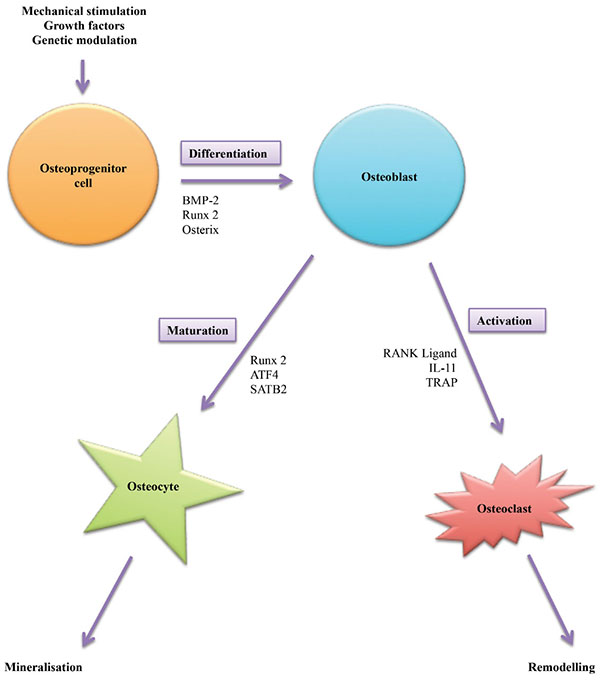Osteoprogenitor Markers
Related Symbol Search List
Immunology Background
Overview of Osteoprogenitor Markers
Mesenchymal stem cells (MSCs) have the ability to differentiate into osteoblasts, chondrocytes, adipocytes, and myocytes in vitro. Osteoprogenitor cells are a precursor cell population of skeletal cells that can differentiate into osteoblasts (Ibrahim A., et al., 2016). Osteoprogenitor cell markers can be used to identify and track potential populations of osteoprogenitor cells within the skeletal stem cell population, with a focus on specific subpopulations of stem cells, particularly those capable of differentiating into osteoblasts. The most commonly used markers include alkaline phosphatase (ALP), surface antigen STRO-1, the bone formation signaling molecule RUNX2, and others. These markers can help researchers identify potential osteoprogenitor cells within the stem cell population and further investigate their differentiation and bone tissue generation mechanisms. These markers can be detected and evaluated through techniques such as immunohistochemistry, molecular biology methods like PCR, and immunofluorescence staining. By studying osteoprogenitor markers, we can track and assess the bone differentiation ability of stem cells, uncover the mechanisms by which stem cells contribute to bone tissue generation, and provide theoretical foundations and practical guidance for bone tissue engineering and the treatment of bone diseases.
 Fig.1 Osteoprogenitor differentiation and accompanying gene expression. Under the influence of physical, chemical, and biological stimuli osteoprogenitor cells can be encouraged to undergo osteogenic differentiation giving rise to osteoblasts. (Ibrahim A, et al., 2016)
Fig.1 Osteoprogenitor differentiation and accompanying gene expression. Under the influence of physical, chemical, and biological stimuli osteoprogenitor cells can be encouraged to undergo osteogenic differentiation giving rise to osteoblasts. (Ibrahim A, et al., 2016)
Research Areas of Osteoprogenitor Markers
Researchers' studies of osteoprogenitor markers are aimed at finding specific markers that can identify and localize these cells as factors that promote the differentiation of mesenchymal stem cells to osteoblasts. The following section explores the research area of osteoprogenitor markers in detail.
- Identification and expression analysis of osteoprogenitor markers
Researchers isolate and characterize osteoprogenitors from bone tissue and bone marrow to find unique markers. Some of the common markers that have been identified include alkaline phosphatase (ALP), collagen type I, and growth factor receptor I. These markers can be analyzed by immunohistochemistry, which can be used to identify and analyze the expression of these markers. These markers can be quantified and localized by immunohistochemistry, flow cytometry, and gene expression analysis.
- Bone tissue regeneration and repair
The study of osteoprogenitor markers is important for bone tissue regeneration and repair. By identifying and isolating osteoprogenitors and utilizing the localization properties of their markers, researchers can selectively promote bone regeneration. For example, one study found that combining ALP (osteoprogenitor markers) with bioceramic composites could promote the repair and regeneration of bone defects.
- Bone-related diseases and therapies
Research on osteoprogenitor markers is also playing an important role in the therapeutic area of bone-related diseases. For example, for the treatment of diseases such as osteoporosis, researchers can use osteoprogenitor markers to localize the location and improve bone density and strength through stem cell transplantation and the application of biomaterials.
- Tissue engineering and stem cell therapy
Researchers are using osteoprogenitor markers to direct the differentiation of stem cells and apply them in tissue engineering and stem cell therapy. By judiciously selecting osteoprogenitor markers and combining them with materials through bioengineering techniques, artificial bone tissues can be constructed with greater functional integrity and potential. For example, one study successfully directed the differentiation of osteoprogenitors into osteoblasts and applied them to tissue engineering for repairing bone defects (Feehan J., et al., 2018).
Many meaningful results have been achieved in the study of osteoprogenitor markers as differentiation factors for MSCs. These studies have provided new ideas and methods for the regeneration, treatment, and engineering of bone tissue. With further research, we believe we will gain a deeper understanding of the mechanism of action of osteoprogenitor markers and promote their development in clinical applications in practice.
Reference:
- Ibrahim A, Bulstrode NW, Whitaker IS, Eastwood DM, Dunaway D, Ferretti P. Nanotechnology for Stimulating Osteoprogenitor Differentiation. Open Orthop J. 2016 Dec 30; 10:849-861. doi: 10.2174/1874325001610010849. PMID: 28217210; PMCID: PMC5299582.
- Wu, F., Wu, Z., Ye, Z. et al. PLGA/BGP/Nef porous composite restrains osteoclasts by inhibiting the NF-κB pathway, enhances IGF-1-mediated osteogenic differentiation, and promotes bone regeneration. J Biol Eng 17, 45 (2023).
- Feehan J, Nurgali K, Apostolopoulos V, Al Saedi A, Duque G. Circulating osteogenic precursor cells: Building bone from blood. EBioMedicine. 2019 Jan; 39:603-611. doi: 10.1016/j.ebiom.2018.11.051. Epub 2018 Dec 3. PMID: 30522933; PMCID: PMC6354620.

